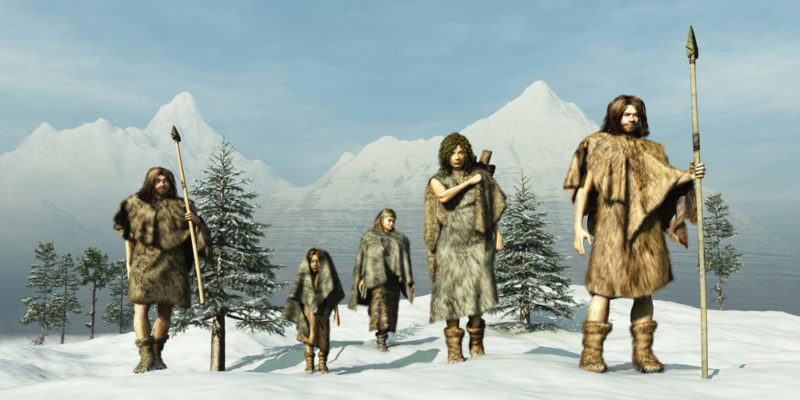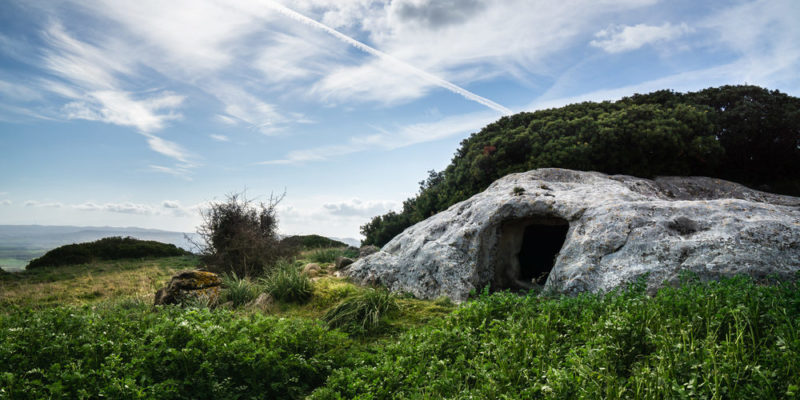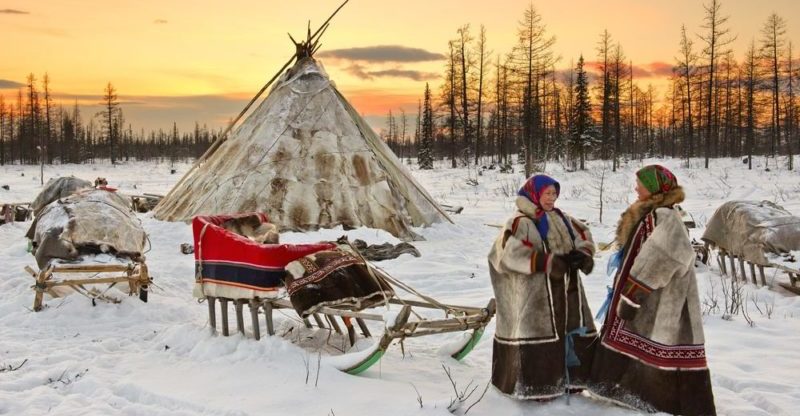We explain what nomadic and sedentary peoples are and what their social structure is like. Also, what are their characteristics and cultures.
What are nomadic and sedentary peoples?
When speaking of nomadic peoples (or nomads) and sedentary peoples, one is referring to the type of modus vivendi or way of life by which they are governed . In this case it has to do essentially with the idea of staying in the same place or wandering around.
Nomadic peoples are those who do not have a fixed and established home , but their home is where they are. They are called semi-nomads (intermediate category) to those who install their home in a certain place temporarily, and when that location is not convenient for them, they move it to another site.
On the contrary, sedentary peoples are those that are located in a single location and make it their home, modifying it to meet their needs. They usually remain there for their entire lives , and are only absent for short or medium trips.
General differences

The difference between nomadic peoples and sedentary peoples is, in principle, the decision to constantly migrate or to remain in the same place , which will henceforth be their home.
However, many others follow from this seemingly simple difference.
This is because they are organized differently, have different cultural values, and develop different technologies .
For example, a nomadic people who live by hunting and gathering , are interested in developing hunting tools, weapons or utensils to create various objects of common use. In all cases, they will be tools of small size and light weight, to facilitate their transport. This includes items they use to protect themselves from the elements.
On the other hand, sedentary people are interested in the construction of more resistant and durable structures to use as a safeguard for themselves and their belongings. In addition, they develop technologies for agriculture, which guarantee the availability of food and allow them to stay in the same place.
The fundamental principle of nomadism is that people move towards resources , while sedentary lifestyle implies that resources move towards people or are produced by them.
History
In the history of our species, nomadism and sedentary lifestyle represent a before and after . The nomadic way of life was the first to be adopted by prehistoric human beings , whose livelihood came precisely from hunting and gathering. As soon as resources ran out in one area, they had to move to another.
Later, during the Neolithic (10,000 years ago more or less), the first human settlements appeared in the Middle East , and with them came agriculture and the domestication of animals , the basis of most of the later civilizations. The emergence of cities is considered the peak of the settlement process.
How did nomads live?

All humanity comes from Africa . When the number of hominids increased , nomadism was a resource to compete for available resources . Each community searched for new territories to find food, which was obtained through hunting and gathering.
This behavior generally occurred within certain geographic parameters. The nomadic tribe did not usually move randomly , but cyclically moved around certain territories, as resources were depleted and renewed.
They could be in one place for a period, then move to another and after a certain time return to the initial one. For this reason, "monuments" or landmarks are still preserved from these times . It is estimated that they indicated places that were used periodically for rituals or for meetings between different peoples.
Besides these cycles, there was nothing permanent or fixed in his way of life . They were excellent hunters, trackers, and gatherers, often having to move when a larger predator , or a more ferocious and more numerous tribe, met them in location.
Sedentary communities

Unlike nomads, sedentary people are usually born, live and die in the same place , which is their home. When they migrate, they often do so under extreme circumstances, such as catastrophes or enemy invasions.
The sedentary found populations , choose to live in community, sharing space. For this reason, they develop technologies and knowledge that allow places to sustain them indefinitely . These technologies include domestication, agriculture, construction, livestock, forging, etc.
Since they remain in one place, where all their valuable possessions are, the sedentary also had to defend themselves from looting by other nomadic or semi-nomadic tribes. This was possible thanks to the organization and division of labor .
In everyday life, sedentary people tend to be more comfortable and grow up in a safer environment . In these communities the exchange of knowledge is encouraged. Territorial notions are also transmitted, that is, to the notion of a community whose identity is somehow linked to the land in which they live.
Different social organizations
The ancient nomadic tribes had fluid organizations . This was not only due to its constant movement, but also because its members were constantly exposed to the dangers of hunting and wandering.
That is why their leaders did not usually last long . Decisions were usually determined by the will of the elders, generally of a dominant father or a patriarchal order, of vertical authority and submission by force.
The tribe's commitment was aimed at subsistence and their culture. Their traditions were transmitted orally and their customs were governed by the seasons, the stars and nature.
In contrast, the sedentary had more time and better conditions to organize socially and politically, define laws , debate and form institutions . Also, sedentary cultures invented writing . Agriculture, in addition, as a means of sustenance is much more efficient than hunting, since it produces more food.
The surplus obtained led to trade , increased social contact with other communities and allowed more balanced diets. This surplus allowed some citizens to be freed from productive agricultural work, to dedicate themselves to invention, military training, religion or science .
The first sedentary

The path to sedentariness of the species was not linear. There were many returns to nomadism and many failed attempts to create settlements. However, it ended up being successful, in part due to the following reasons:
- The success of agriculture as a model. Especially when world temperatures rose at the end of the last ice age.
- Greater margins of survival. Protection of wild animals, better distribution of food, less exposure to the dangers of the elements, formation of armies.
- Fixed social and political structures. Predictable rules of the game , order and authority during complex periods, etc.
Nomadic cultures
Nomadic peoples existed throughout each of the five continents . And despite their notable differences, it is possible to trace some essential characteristics of their culture:
- A more harmonious relationship with nature, of which they feel part.
- Polytheistic or pantheistic religions, with little roots for a pilgrimage site.
- Mostly oral tradition, with a high sense of story and song.
Historical importance of sedentary lifestyle

Our culture and civilization is predominantly sedentary . Philosophers such as Deleuze and Guattari pointed out that the history of humanity has focused from early times on sedentary cultures, leaving aside the contributions of nomadic cultures or suspecting populations that were reluctant to settle.
At present, it is undeniable that sedentary life allowed the beginning of what we understand today as human civilization . Our basic subsistence criterion is the accumulation of goods and the division of labor, two things that would have been very difficult to follow with a nomadic model of life.
The cities
The city is the peak of sedentary culture, to the point that it considers itself a separate territory , different from the one that surrounds it. The first cities arose in the Middle East 10,000 years ago.
From the beginning they were important centers for the accumulation of wealth , translated into food, new knowledge and valuable artifacts. In addition, they had large infrastructure works for war purposes (such as walls), rituals (such as temples or funerary buildings) or administrative (such as palaces).
Current nomadic peoples

Some nomadic peoples of the world today are:
- America . The Pehuenche, Puelche and Kollas (Chile); the Nunak, Makú and Wayúu (Colombia); the Yanomami (Venezuela); the Chichimecas (Mexico) and the Inuit or Eskimos in Greenland.
- Africa . The Tuareg, the Saharaui (Sahara region); the Pygmies, Baka, Twa, Binga, Mbuti (central Africa); the Khoisán (South Africa), the Maurí (Mauritania), the Turkana (Kenya).
- Europe . The gypsies or gypsies.
- Asia . The Bedouins (Middle East), the Gadulia Iohar, Rabari ( India ); the Rají ( Nepal ),the Mongols (Mongolia), the Evenis and Nenets (Russia), the Yoruk (Turkey) and the Kochi (Afghanistan).
- Oceania . The Aetas of the Philippines.
MA student of the TransAtlantic Masters program at UNC-Chapel Hill. Political Science with a focus on European Studies. Expressed ideas are open to revision. He not only covers Technical articles but also has skills in the fields of SEO, graphics, web development and coding. .
Leave a reply
Your email address will not be published. Required fields are marked *Recent post

Sport: What Is It, Types, Risks, Features, Characteristics and Examples

Dogs: Emergence, Features, Characteristics, Feeding and Breeds

Story: Definition, Elements, Structure, Features and Characteristics

